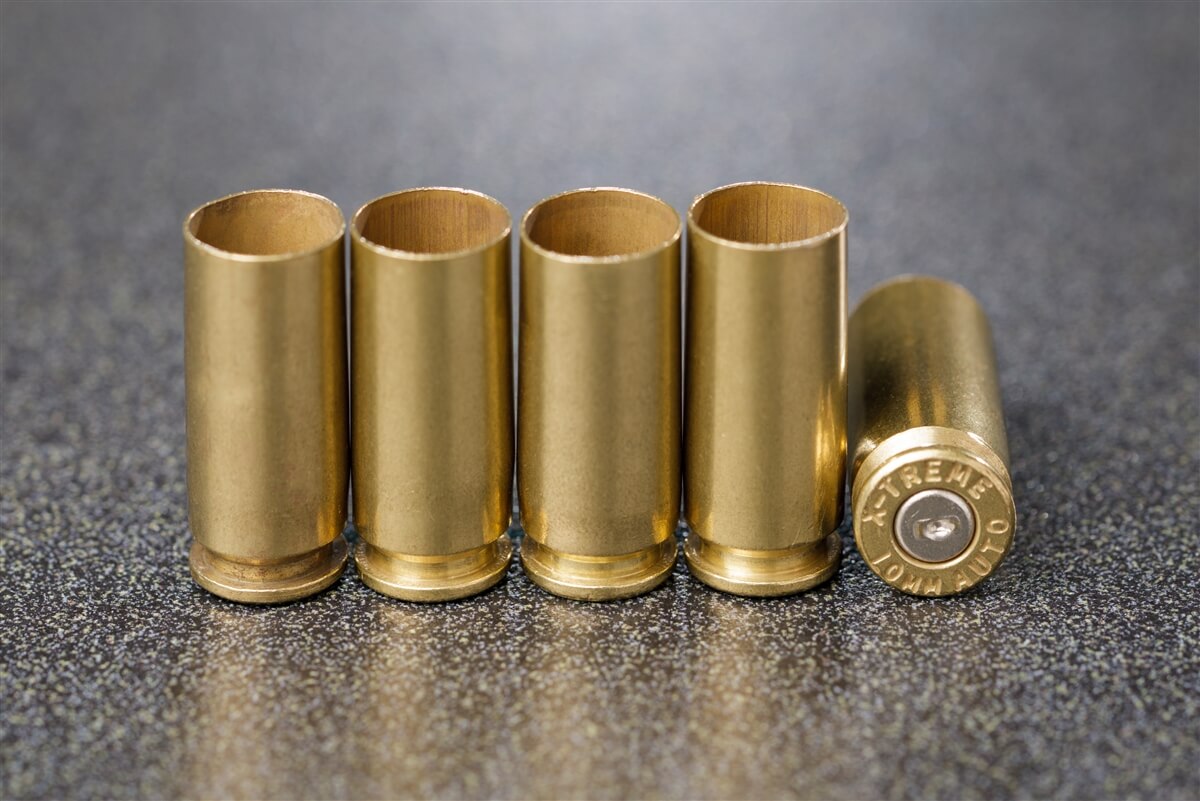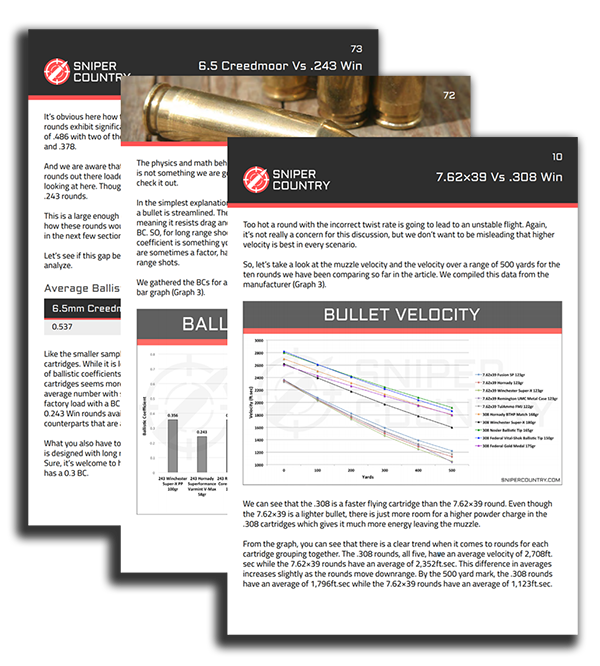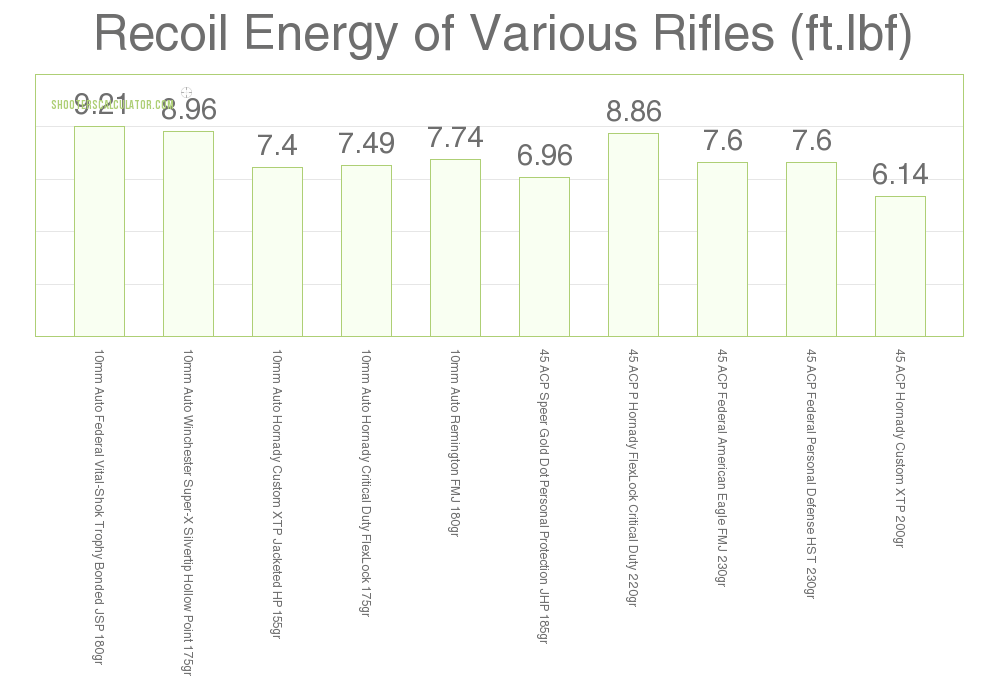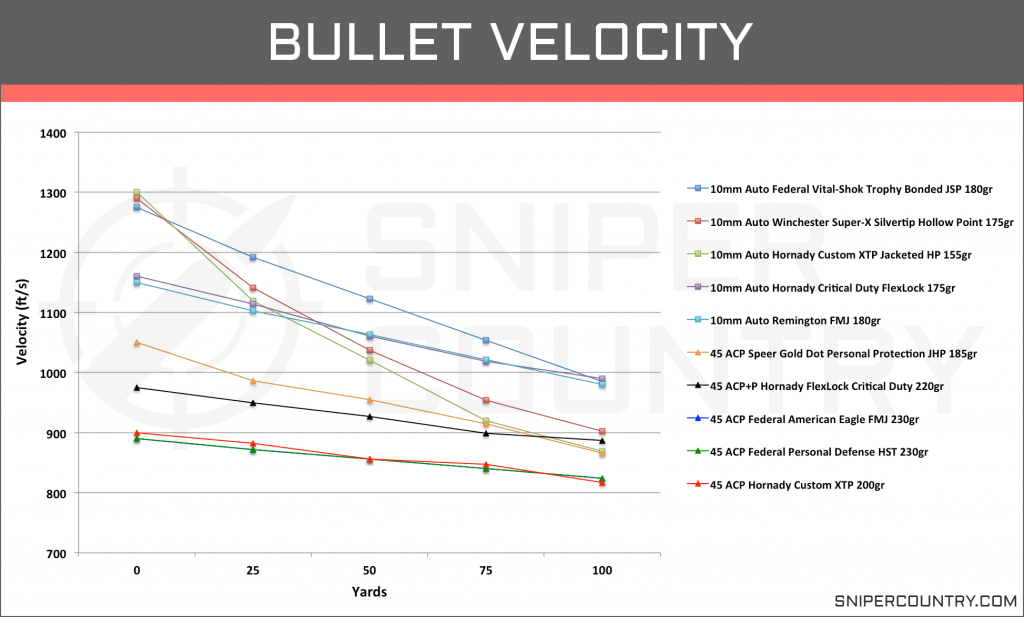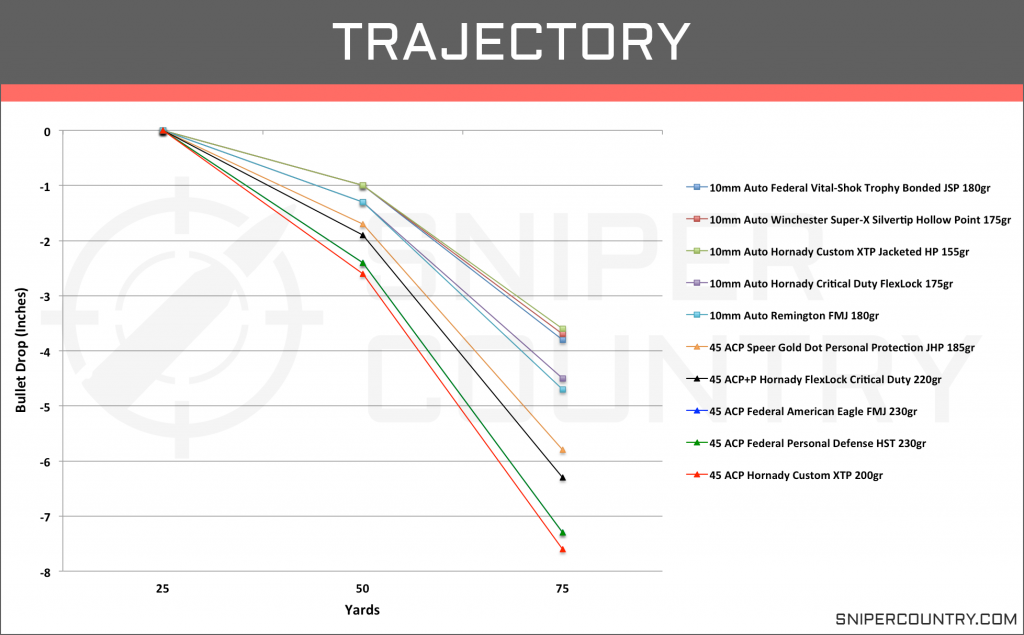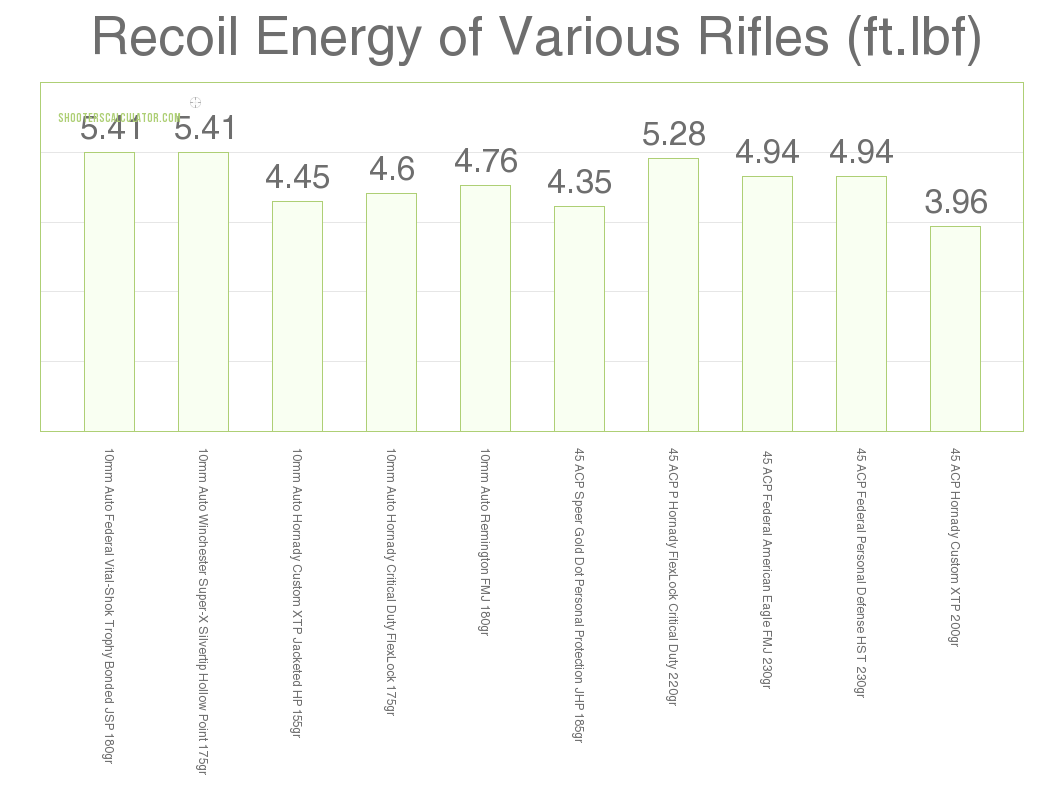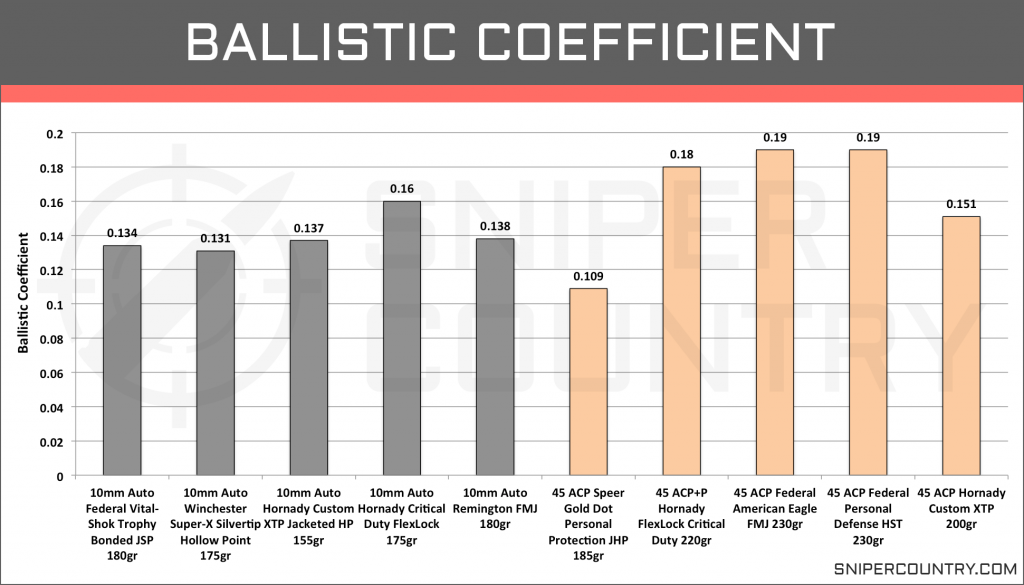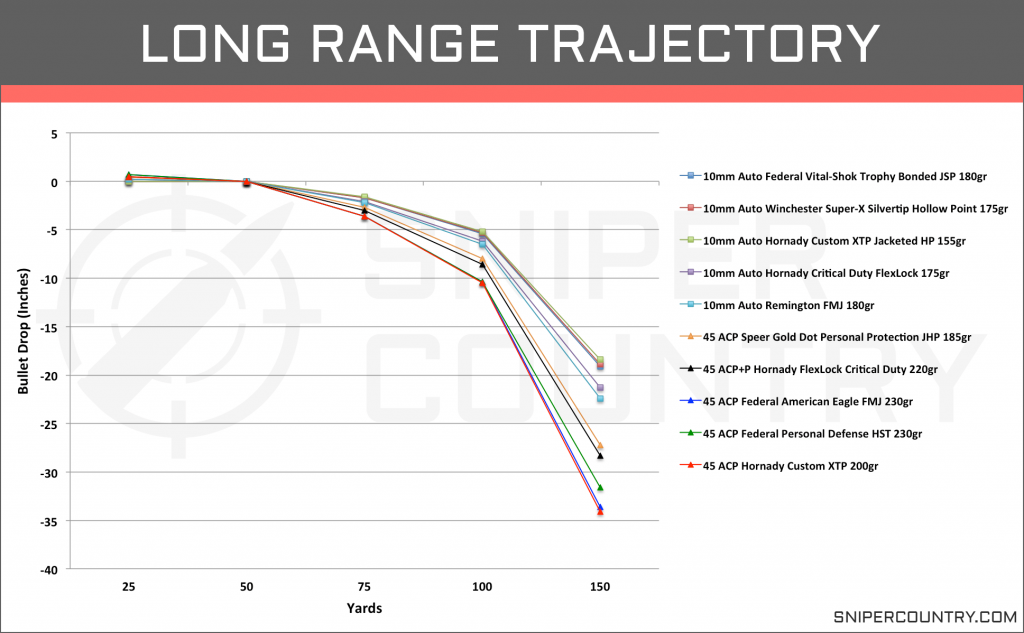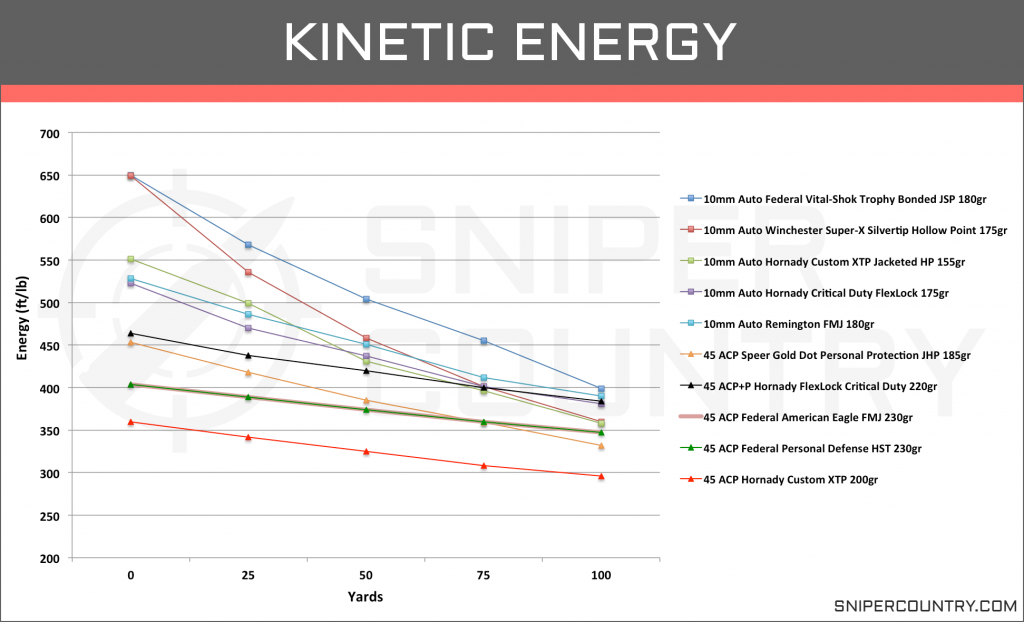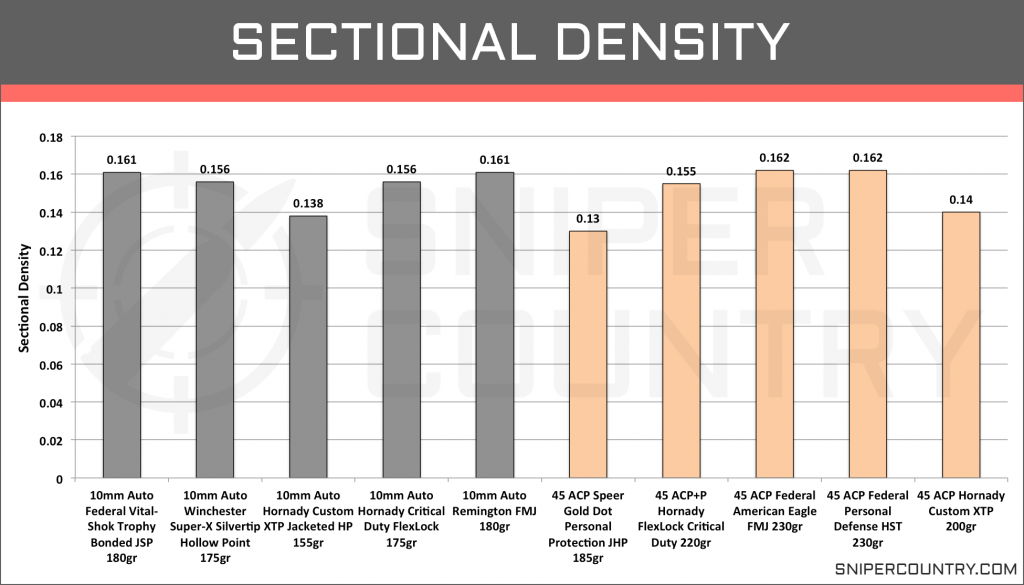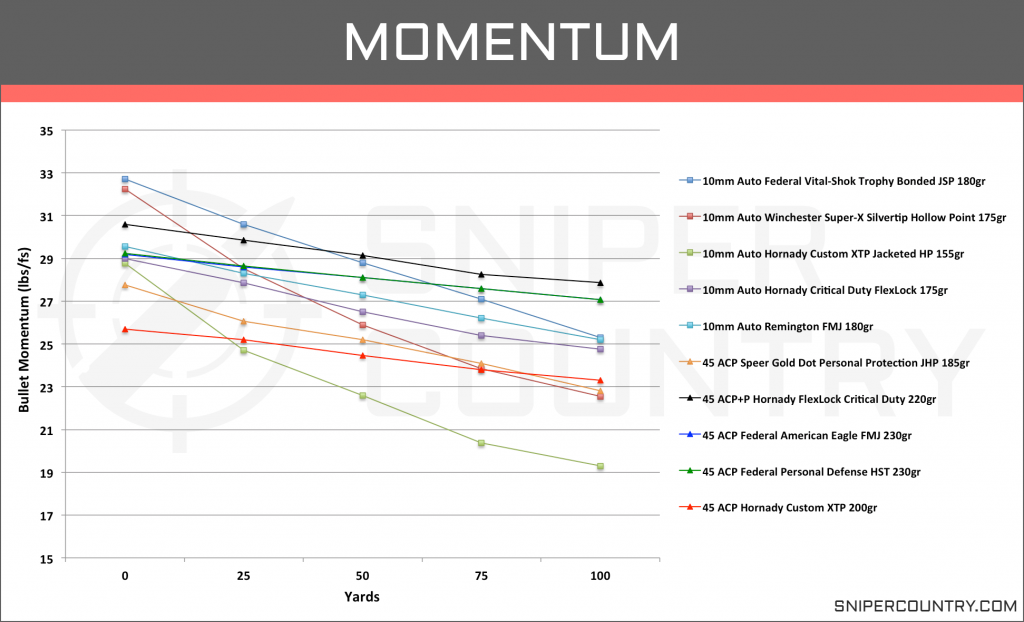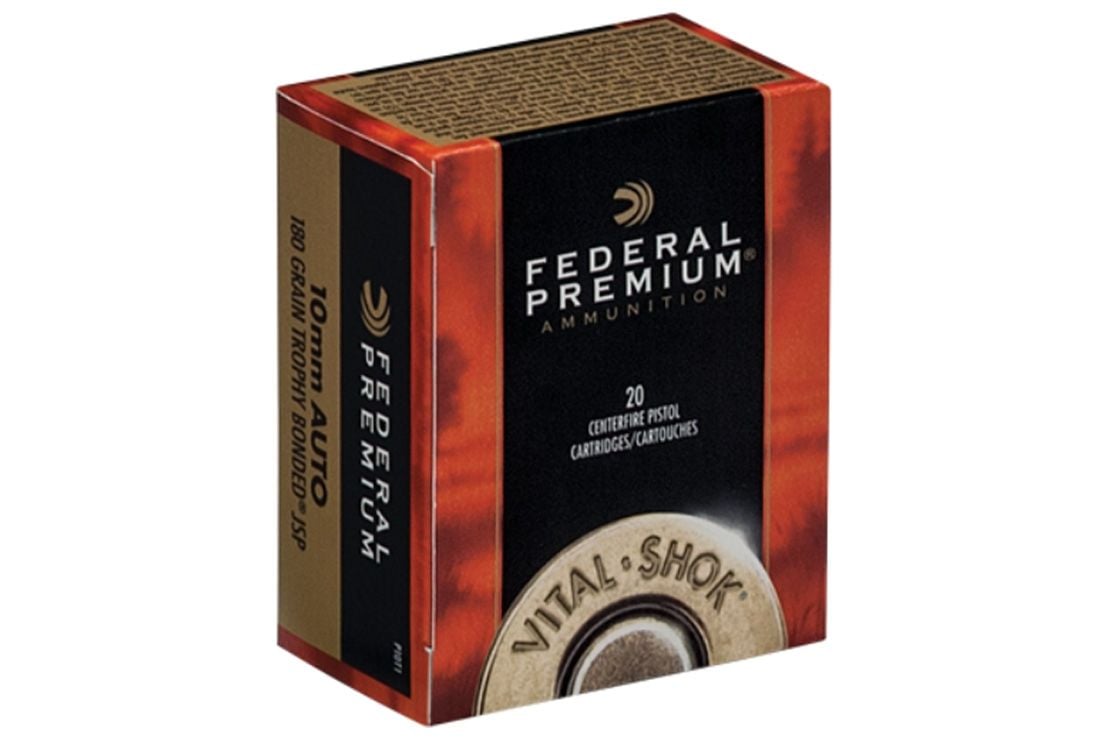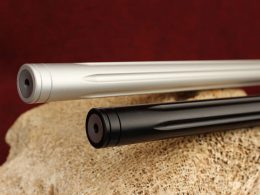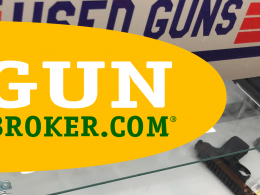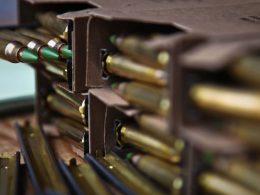In this Article:
When looking at the 10mm vs .45 ACP, we are looking at a cartridge that has been proven over and over for over a century, and we are looking at a cartridge that came out hot in the 1980’s, tapered off, and has been surging back into the shooting world.
Both of these cartridges offer you excellent stopping power and are considered heavy hitters for personal defense against home invaders and attackers, both human and dangerous game. And interestingly, they go about it in different ways. Low velocity and heavy bullets of the .45 ACP and slightly lighter and faster rounds of the 10mm.
With these two rounds overlapping in their applications, we wanted to do a side by side comparison of the rounds. And we have no intention of attempting to label once cartridge as better than the other. Instead, we want to take an unbiased look at several ballistic and other performance specs of these cartridges in the hopes that we can tease apart where each cartridge might be better suited. It’s not about pushing our agenda or trying to push our opinion on anyone. We write this to benefit you and hopefully help you in wading through all the information and options that are out there.
A Brief History
10mm Auto
The 10mm Auto is a intriguing round in he handgun world. A common theme you will run into when people are discussing the 10mm Auto is that it falls into an awkward weird little crevice somewhere between the performance of a .40 S&W or 9mm and the performance of larger calibers such as the .45 ACP and .357. And if you run into that sentiment, you will usually find an argument against it following soon after.
The 10mm has not garnered the attention and acceptance into the mainstream shooting circles, but this 40 cal cartridge does have a cult following. The 10mm Auto was developed by Jeff Cooper in the early 1980’s, and it’s initial development gained a lot of press though. It was a pistol cartridge that provided better trajectory and range than the .45 ACP but provides more stopping power than the 9mm and other .40 cals. It also hit pop culture with the Bren Ten in Miami Vice. A lot of quality issues plagued the rounds acceptance into the mainstream handgun cartridges.
The 10mm Auto was also adopted by the FBI due to its power in the mid-1980s. Its service didn’t last long and was attributed to the recoil which was deemed unmanageable for your average agents. Eventually, it was replaced by a different .40 cal round, the .40 S&W.
Barring some of the major setbacks early in its development and distribution and without the development of other .40 caliber handguns, the 10mm Auto could have easily been more popular in today’s world. But it is still here, and that speaks for something and in recent years has been gaining in popularity.
There are a lot of options for bullet weights ranging from 135 to 230gr though you are more likely to find rounds in the 155-180gr weight range.
.45 ACP (Auto Colt Pistol)
The .45 ACP was designed by John Browning in 1905 to provide the US cavalry with a pistol round with significantly more stopping power.
The .45 ACP has someone very recognizable and historical weapons such as the Thompson submachine gun. It has been used as the official cartridge for the sidearms of the US military, seen military use in several wars in submachine guns, and has been associated with the historical gangsters of the 1920’s.
In today’s shooting world, the .45 ACP is still regarded as one of the top personal defense rounds regarding stopping power. You can find .45 ACP cartridges in a wide range of bullet weights with most of them falling in the 165-230gr weight range though there are lighter options available. The .45 ACP is known for low muzzle flash and pretty mild recoil given that they are normally not loaded very hot and despite firing heavy rounds. The heavy bullet weights and lower velocities are ideal for the creation of large wounds, which is often sought after for home defense. One of the downsides to the .45 ACP is that handguns chambered for this cartridge carry fewer rounds than other cartridge options, including the 10mm Auto.
Specs
| 10mm Auto | .45 ACP | |
|---|---|---|
| Parent Casing | .30 Remington | 0.41 Cal Prototype |
| Bullet Diameter | 0.4005†| 0.451†|
| Neck Diameter | 0.423†| 0.473†|
| Base Diameter | 0.425†| 0.476†|
| Case Length | 0.992†| 0.898†|
| Overall Length | 1.25†| 1.275†|
| Case Capacity | 24.1gr | 26.7gr |
| Max Pressure (SAAMI) | 37,500psi | 21,000psi |
Before we get into comparing the performances of these two cartridges we want to take a look at the casing and overall cartridge specs. By looking at the bullet and casing specs of these two cartridges, we can begin drawing some inferences about how these two cartridges will perform. It also gives us something to look back on when we see the numbers and help us make more sense of them.
Both of these cartridges use pretty large caliber bullets with the 10mm utilizing a .4005 inch diameter bullet with the .45ACP utilizing a wider .451 inch diameter bullet. The .45 Acp has a slighter wider neck and base diameter, though a shorter case length. The .45 ACP has a slightly longer overall length by .05â€.
One interesting difference between these two cartridges is the disparity between the max pressures while the case capacities are similar. Though factory loads are dialed down quite a bit, the 10mm is often loaded with more powder than the .45 ACP. While the .45 ACP can be loaded hotter, it increases the recoil, and it takes away some of the pros for the .45 ACP which is regarded as a heavier, slower round that operates at lower chamber pressures.
As I mentioned, these are the ten rounds that we will be using for this comparison. All of these are widely available factory loads that see a lot of use in the field.
 10mm Auto Federal Vital-Shok Trophy Bonded JSP 180gr
10mm Auto Federal Vital-Shok Trophy Bonded JSP 180gr 10mm Auto Winchester Super-X Silvertip Hollow Point 175gr
10mm Auto Winchester Super-X Silvertip Hollow Point 175gr 10mm Auto Hornady Custom XTP Jacketed HP 155gr
10mm Auto Hornady Custom XTP Jacketed HP 155gr 10mm Auto Hornady Critical Duty FlexLock 175gr
10mm Auto Hornady Critical Duty FlexLock 175gr 10mm Auto Remington FMJ 180gr
10mm Auto Remington FMJ 180gr
 .45 ACP Speer Gold Dot Personal Protection JHP 185gr
.45 ACP Speer Gold Dot Personal Protection JHP 185gr .45 ACP+P Hornady FlexLock Critical Duty 220gr
.45 ACP+P Hornady FlexLock Critical Duty 220gr .45 ACP Federal American Eagle FMJ 230gr
.45 ACP Federal American Eagle FMJ 230gr .45 ACP Federal Personal Defense HST 230gr
.45 ACP Federal Personal Defense HST 230gr .45 ACP Hornady Custom XTP 200gr
.45 ACP Hornady Custom XTP 200gr
We wanted to note that for the .45 ACP rounds, we have included a +p round. While these are considered variants of the standard cartridge, they are available and popular, so we wanted to include one of our picks. The +p indicates that the cartridge is loaded hotter than standard factory loads and should bring up some good points for discussion.
This is a small sample set given the number of options that are out there, and we are very aware of the limitations when using such a small sample size. We did not only looked at these ten rounds. We also compiled twenty rounds for each cartridge type. Now, we are not going to graph and discuss all forty rounds because that would bog down the graphs and the discussion. We do want to give you some numbers from all of these rounds, and we will list tables in most of the different performance sections the averages of these various rounds. You will see that the differences and trends between the smaller sample size match with the same differences and trends when looking at all forty rounds.
All of these rounds are available and popular factory loads. Factory loads tend to err on the side of caution when it comes to loading the casings with powder. So, if you have come across some forum or been at the range with guys talking about numbers that seem a lot more intense then what we are talking about here, it’s most likely they are using hand loaded cartridges.
We also want to note that all of the data here is computer generated. The majority of the data is available from the manufacturer, and where that was not available, we relied on ballistic calculators from trusted sources. Where ballistic calculators are used we kept as many variables the same between rounds of the same cartridge. Where calculations are made, we will be sure to make clear our variables and what was used for each cartridge.
When it comes to this type of data, there is no concern with comparing cartridges, but you should be aware that these numbers can change when being fired from your handgun. Each handgun tends to have its own profile, and this means some small differences in the ballistic output such as higher or lower velocities which effects a lot of other categories.
As far as comparing the two cartridges go, computer-generated data has its advantages in that environmental variables and these differences in firearm profiles are negated, so the trends are uniform across the board. So keep in mind that different powder loads, different barrel lengths, and different sight lines can all affect the numbers. As long as the variables are kept consistent for each cartridge, the trends shouldn’t change.
We also think that there is an important issue to discuss before jumping into the thick of things, and that is what is important when choosing between handgun cartridges. We think the majority select a handgun round on their ability to wield it and that it’s going to stop an intruder or dangerous animal quickly. For the former, we can look at that pretty easily though it is still relative to who is handling the gun and cartridge. For the latter, it gets a little tougher. We will discuss this more at length when we get into stopping power between the 10mm vs .45 ACP.
So, let’s first take a look at a big component of deciding between two cartridges, the recoil.
Recoil
Recoil is incredibly important when it comes to comparing and choosing between handgun ammunition. Whether it is for home defense or tactical competitions, recoil is a big player in how effective you can be with the weapon. There’s no doubt you can adapt to the recoil with practice, but with adrenaline coursing through you in real situations, you want to be confident that you can send several rounds downrange quickly and accurately and recoil is a big factor.
We are not looking or trying to quantify how the cartridge and handgun feels when firing. Instead, we are only looking at the energy that is generated from firing the round. While this energy does translate to felt recoil, it is quantifiable. Felt recoil takes a lot of other factors into account that is difficult to put numbers with including the handguns grip and the positioning of the shooter. This also does not give you any information on how the kick feels in your hands. Some cartridges give a much sharper kick with muzzle flip while others seem to push back more in your hands similar to a shotgun. And the differences in how the recoil feels can even vary between different rounds of the same cartridge type.
With that, it makes it quite important to get a little experience shooting both cartridge types to tell how difficult it is going to be for you to handle.
We used a ballistics calculator to generate the graph below (Graph 1).
To calculate the recoil energies we used the muzzle velocity, a constant gun weight, and a constant powder charge for each cartridge type. The powder loads do differ between the two cartridges. For the powder load, we used Nosler load data and went conservative with both given we are working with factory loads. We should note that these numbers are going to vary based on the weight of your firearm, but it should still give us a good idea of how these two cartridges differ in the actual recoil energy. For whatever reason, factory loaded 10mm rounds are almost always loaded conservatively. For handloading, you are probably going to see a significant increase in recoil energy for the 10mm.
Both of these cartridges have pretty similar recoil energies. All of these rounds fall below the 10ft.lb mark though the 10mm does have two rounds in the very close and above the .9 mark. The .45 ACP has several rounds that are below the 7ft.lb mark though the +p round has recoil energy of 8.86, which is more similar to the 10mm rounds. We are also seeing lighter bullets being used for the 10mm rounds so even though they are leaving the barrel quite a bit faster than the .45 ACP rounds, the recoil energy is not jumping up too much. A 200gr 10mm around the same muzzle velocities is going to pack a punch when it comes to recoil.
Both of these cartridges have some pretty intense recoil compared to other handgun rounds. And again, this is just looking at the recoil energy and not how the recoil feels. A lot of users will tell you that the 10mm and .45 ACP have very distinct kicks. And while these are pretty high recoil energies, we don’t think it is too much for any adult to handle with some practice.
In the table below, we have listed the averages for all forty rounds.
Average Recoil Energy (ft.lb)
| 10mm Auto | .45 ACP |
|---|---|
| 8.8 | 7.22 |
Ballistics
In the ballistics section, we are going to look at a couple of different categories. The first is velocity, which a lot of handgun users usually key in on. We are also going to look at the short range trajectory of these ten rounds. For the most part, shots within 15 yards there is not a lot of bullet drop happening, but we will still examine any differences between these two cartridges as the bullets move downrange a bit.
We also want to take a look at the ballistic coefficients and a bitter longer range trajectory. This is not usually an aspect looked at when discussing handgun cartridges, but we think it can be quite interesting when discussed with regards to use in carbines and sub rifles chambered for these cartridges.
Unlike centerfire cartridges, the ballistics are not as hot a topic outside of velocity, when it comes to handgun rounds. There is still a lot of information there and given some of the applications for these two rounds, we wanted to take a closer look.
Velocity
Velocity is a key component when looking at a comparison between cartridges because it has its hand in just about every category that you will look at.
For handgun rounds, velocity is most examined for its terminal ballistics. You want enough velocity so that you get the proper expansion when the bullet hits the target. Depending on what you are shooting at and the intended effects you want, you might want rounds with a higher velocity. There are also situations where you might want a bit lower velocity. The important concept is that the velocity is going to give you the proper expansion and level of tissue damage.
In this case, where we are going to look at the use of these rounds in carbines, it is also an important factor in bullet stability and reducing the amount of time environmental factors have to act on the bullet’s flight.
Since we want to look at a more general cartridge comparison, we are not going to go down the route of looking at each round’s bullet design. The same style of bullets is used for most different cartridge types, so it doesn’t tell us anything regarding the 10mm vs .45ACP argument. It’s definitely important when choosing a certain round.
We compiled the velocity data from these ten rounds from their manufacturers and graphed them below (Graph 2).
We are looking at the velocity (ft.s) from the muzzle out to 100 yards.
From the graph, we see some trends between the two cartridges. With muzzle velocity, the 10mm rounds (average of 1,235fps) have a significant amount more velocity than the .45 Acp rounds (average of 941fps). When looking at individual rounds, there are cases where the 10mm round is traveling nearly 400fps faster than the .45 Acp round. Of course, there are also cases where the difference is only 100fps.
The 10mm rounds also tend to stay above the 1,000fps mark until the 75 to 10-yard mark while all of the .45ACP rounds except for the Speer Gold Dot round leaves the muzzle under 1,000fps.
We also see the 10mm rounds bleed velocity at a higher rate than the .45 ACP round. By the 50 yard mark, the difference in the average of the cartridges shrinks to 170fps, and by the 100-yard mark, the difference is 101fps with the +p cartridge actually having a higher velocity than several of the 10mm rounds.
Average Bullet Velocity (ft.s)
| Yards | 10mm Auto | .45 ACP |
|---|---|---|
| 0 | 1198.6 | 942.5 |
| 25 | 1118.7 | 909.4 |
| 50 | 1055.1 | 891.2 |
| 100 | 958 | 833.4 |
Trajectory
Yeah, it seems strange to see the word trajectory in a comparison of handgun rounds. But, we didn’t see any reason not to include just a short little discussion on the topic, and it might even launch us into some good talking points.
We are also going to look at the use of these cartridges in carbines as well, so it doesn’t hurt to introduce the topic now.
All we are looking at is how flat these rounds shoot. As a bullet moves downrange and loses velocity and has gravity working on it, it is going to lose altitude. The more pronounced the bullet drop, the more skill it takes in adjusting the shot. Now, for most situations people are using handguns, the trajectory makes little difference, but once you get out to the 30+ yard range, there might be some difference between two different cartridges.
The range that people usually have in mind when it comes to using their handgun is going to differ. If it’s intended use is home defense, you’re thinking shots out to 15 yards at the max and trajectory is not really a concern. If you like to head to the range and go through some tactical drills, you might need some extended range on your shots to a couple dozen yards. For most handgun rounds, the trajectory at these ranges are going to be very similar with minimal differences in bullet drop. Still, there is no reason to leave the stone unturned. And depending on your personality, a quarter inch difference in bullet drop at 50 yards might be enough to swing you one way or the other.
We compiled the trajectory numbers and graphed them over a range from 25-75 yards with the handguns sighted in at 25 yards (Graph 3).
The differences between these two cartridges at the 10 yards were less than .005†between the cartridges and left out of the graph to make it a little cleaner.
We see that all five rounds from each cartridge have some variation to them but tend to group together with no overlap between the rounds at the 50 or 100-yard mark. The 10mm rounds show a flatter trajectory with an average bullet drop of 1.12 inches at the 50-yard mark and 4.06 inches at the 100-yard mark. The .45 ACP rounds show an average drop of 2.2 inches at the 50-yard mark and 6.86 inches at the 100-yard mark. And those are of course averages. If you look at individual rounds, there are cases where the difference between a 10mm and .45ACP is as little as 0.3″ at the 50-yard mark and 1.1 inches at the 100-yard mark.
Average Bullet Drop (Inches) at Short Range
| Yards | 10mm Auto | .45 ACP |
|---|---|---|
| 25 | 0 | 0 |
| 50 | -1.11 | -2.43 |
| 75 | -4.15 | -7.64 |
Carbine
We want to step outside the normal discussion when it comes to handgun rounds and look at the performance of the 10mm vs .45 ACP when used with carbines.
A carbine is a pretty general term and encompasses a wide array of gun designs. Most think of military carbines that still used the same ammunition as the full-size rifles, but there are carbines that utilize ammunition more associated with handguns. There are the classic lever action carbines as well as the more modern compact semi-auto sub guns that fall into the carbine category. Falling somewhere between a pistol and full-size rifle, carbines offer several advantages when using what most consider handgun rounds.
Compared to a rifle, they are shorter and lighter which makes them more manageable in tighter quarters. When compared to a handgun, the carbine offers easier handling, when you have the room, and easier shot alignment since you can fire from the shoulder as well as more points of contact and a longer sight radius. The increased weight also helps reduce the amount of recoil you will have to deal with. Carbines also provide more room for tactical gear that can make target acquisition easier.
Compared to other handgun rounds, there are not as many options for carbines chambered for these two cartridges, but we think it might be of use to someone to go ahead and take a look at the data anyway.
Carbines and Recoil
With increased weight and barrel length, in most cases for carbines, though some sub guns are incredibly compact, there is going to be a difference in the recoil energy when these same rounds are fired. The increased barrel length also adds some velocity to the rounds as they leave the muzzle.
We calculated the recoil data with the above changes in mind and have the results below (Graph 4).
We see the same trends as we saw with the previous recoil data. The difference is the recoil energy has been reduced by several ft.lbs of energy. Now, these numbers can be a little higher or a little lower depending on your carbine, but you see the trend. And a few ft.lbs of energy might not seem like much, but it can make quite a difference when making successive shots.
Ballistic Coefficient (BC)
In the simplest of terms, the ballistic coefficient is a number that is derived from an equation taking into account a variety of bullet flight specs. The higher the ballistic coefficient, the less prone to wind resistance and drag the bullet is. In theory, a bullet with a better ballistic coefficient should be more accurate since it should be easier to stay on target after being fired.
Even with shooting these rounds through a carbine, we are not talking the ranges of centerfire rifles. We can also look at the velocities of these rounds and realize that their performance is going to suffer as they move downrange, even with a longer barrel carbine adding a few hundred fps. Because of this reduced range, the ballistic coefficient will not have as large an impact on handgun cartridges at short range when compared to centerfire rifle cartridges at 300+ yards.
Still, with the reduced velocities of these rounds at 75+ yards and with a lot of them being designed with wound characteristics rather than aerodynamics in mind, a BC that can help give you a half inch less bullet drop or resist a crosswind better is something to look at.
We compiled the ballistic coefficients of these rounds and graphed them below (Graph 5).
Compared to some rifle cartridges, these BCs might look pretty weak, and they are, but given the intended purpose of these rounds, no one would expect a .5 BC 10mm or .45 ACP.
The .45ACP rounds used in this comparison do have a slightly higher average BC than the 10mm rounds, but it is mainly due to the heavier 230-grain rounds. Add in a couple 200gr 10mm auto rounds, and we are looking at near identical BCs.
We are not going to tell you that this is a useless comparison. The vast majority of users for either of these cartridges are not going to spend any time weighing the BCs given what they are designed to do. We just like to be thorough and in the off chance someone is interested, here you go.
Long-Range Trajectory
A carbine has several advantages to a handgun. We’re not saying they are better than a handgun, just that they have a few advantages (they have plenty of disadvantages as well). One advantage is that it is easier for most people to line up a longer shot using a carbine. We’re sure they are some of you out there that can do as well or better with a handgun than someone with a carbine as a lot of it depends on skill level, but we are speaking in generalities.
With carbines giving you the ability to line up 75-150 yard shots easier, we wanted to take a look at the trajectories of these rounds at those ranges.
We calculated the trajectories with a ballistics calculator and graphed the results from the muzzle out to 150 yards with a zero range of 50 yards (Graph 6).
Like the short range trajectory data, the 10mm auto rounds appear more flat when the range is increased. At 75 yards, 25 yards out past the zero range, the differences are only slight with an average bullet drop of 1.8″ for the 10mm rounds and 3.3 inches for the .45 ACP rounds. The gap widens between the two cartridges as they move downrange with a difference in the averages of 3.86 inches at 100 yards and 10.9 inches at 150 yards.
And like all of the categories, there are individual rounds of each cartridge that give you flatter or steeper trajectories. Given the design of these bullets, the amount of drop you are getting is not that bad. It’s not ideal, especially the .45 ACP rounds, but the 10mm rounds are manageable if you have some good optics.
Average Bullet Drop (Inches) at Long Range
| Yards | 10mm Auto | .45 ACP |
|---|---|---|
| 25 | 0.3 | 0.76 |
| 50 | 0 | 0 |
| 100 | -6.01 | -10.58 |
| 150 | -19.33 | -31.5 |
Special Offer: Join our private community and get exclusive gun deals, handpicked gear recommendations and updates on law changes, every day!
Join our private community
Stopping Power
Besides something political, we are not sure if there is a topic out there that brings about more arguments than handgun rounds and stopping power.
There are a lot of arguments out there, with all sides having some good points, about what makes a handgun round effective and which ballistic category best indicates stopping power. And we think the most important concept to take away from these arguments is an effective handgun round is a round that does what you want it to do. Of course, that is fine when you have the handgun and several rounds to test, but it doesn’t help much when looking at the computer screen and trying to decide.
So what are the different factors that should be considered when arguing stopping power? We have bullet design and the proper velocity to give the correct expansion. We also have kinetic energy which will transfer to the target to cause tissue damage, and we also have sectional density, which corresponds to how well a bullet will penetrate as well as bullet momentum which also is critical in penetration.
Really, it all wraps in together, each influencing the other and resulting in its terminal performance. In our opinion, the most important quality to stopping power is shot placement.
We are going to look at the kinetic energy of the rounds as well as the sectional densities and bullet momentum. Why pick and choose when we could just look at them all. We are more than aware of the other criteria and we don’t discount them. In our opinion, these are the three clearest options when it comes to comparing the 10mm vs .45 ACP with computer generated data.
The data we will look at is completely satisfactory when comparing two cartridges and the categories give us a way to look at stopping power and the ability to get a bullet on target but it is missing an essential component which is terminal performance. And that depends pretty heavily on the specific bullet being used, specifically its design and expansion properties. And for computer-generated data, we can’t simulate those results.
Energy
As we mentioned in the previous section, there is a lot that goes into stopping power. Especially when it comes to discussing handgun rounds and self-defense. And while the kinetic energy carried by a round is in no way the end all method of determining stopping power, it does influence the amount of damage that a bullet will cause.
Both the velocity and the mass of the bullet influence the amount of kinetic energy that a bullet carries. That doesn’t mean that 100% of that energy is going to translate to tissue damage. A lot of that transfer is going to depend on the terminal performance of the bullet such as how it expands and how much is penetrates. A high-speed bullet that rips through the target such as a FMJ is not going to transfer much of that energy to the target. Still, energy levels can give us an indication of how much damage a bullet can potentially cause.
The graph below shows the kinetic energy of each round from the muzzle out to 100 yards (Graph 7).
Out of the muzzle, the 10mm rounds have a distinct advantage over the .45 Acp rounds with an average muzzle velocity of 580ft.lb with several rounds in the 600 to 650 range. The .45 Acp rounds come in with an average of 417ft.lb of KE. And this trend is what we would expect with these loads. The 10mm rounds are coming out with a much higher velocity which is going to increase the KE. And while the .45 ACP rounds used in this article are using heavier bullet weights, the difference in velocity is much greater than the difference in weight.
From the muzzle to 75 yards, there is a clear distinction between the 10mm and the .45 ACP rounds with no overlap between the two cartridges. This trend carries out further to the 75-yard mark when the +p .45 ACP cartridge is taken out of the discussion.
Once the rounds reach the 75 and 100-yard mark we see the average difference between the two cartridges shrink. At 100 yards, the 10mm has an average kinetic energy of 377ft.lb while the .45 ACP has an average of 355ft.lb. And the +p .45 round outperforms several 10mm rounds at this range. How relevant this depends on what you plan on doing with these rounds. 100 yards for both of these rounds is pretty tough given their ballistic properties, but that’s just the data.
Average Bullet Kinetic Energy (ft.lb)
| Yards | 10mm Auto | .45 ACP |
|---|---|---|
| 0 | 579 | 405.8 |
| 25 | 523.5 | 377.6 |
| 50 | 466 | 349.7 |
| 100 | 407 | 320.2 |
Penetration
The SD is derived from a calculation using the bullet’s diameter and weight. A bullet with a higher sectional density should have greater penetration than a bullet with a lower SD. The sectional density alone does not provide a clear indication of how much penetration the bullet will have. The velocity as well as the design of the bullet factor in as well. Higher velocities increase penetration as does highly bonded bullets that will not fragment on impact.
And as we have already mentioned, more penetration is not always an indicator of a better round. It all depends on what you are using the
round for.
The theory behind sectional density and penetration is that the heavier the bullet, the more mass that is behind it when it hits the target. If two bullets have the same mass, we can look at the caliber or diameter of the bullet. The round with a smaller bullet diameter should have more penetration because the force is localized to a smaller area.
Also to note, bullet momentum is linked closely with sectional density when talking about the amount of penetration you can get and will be discussed in the next section.
And this comes back to the argument of what stopping power entails when discussing handgun cartridges. Deeper penetration is wanted when you are using the rounds for hunting purposes. Especially on larger animals where you need to reach vital organs behind thick hide and bone. For home defense, you might not want as deep penetration but instead a large wound cavity. So as we look at these numbers, just remember that they are only half the story and the terminal performance of the bullet is equally important in how the bullet will react on impact.
We calculated the section density for all ten rounds we have selected and graphed them below (Graph 8).
We do not see much of a difference between the two cartridges at first glance. All of the rounds fall in the .13 to .16 range, and both have rounds on each end of that spectrum. From these selected rounds, the 10mm Auto has a slightly higher average in sectional density by about .05. While the .45 ACP rounds usually have a higher bullet weight, the 10mm Auto rounds are not far off, and they have a smaller diameter bullet.
The .45 ACP does have the two highest rounds regarding sectional density, and they have the 230gr bullets. In our selection, we did not include a 200gr 10mm Auto round, but if we had, you would have seen a sectional density of .178.
And I know we keep harping on this, but the sectional density is not the sole variable in how much penetration you are going to get. Bullet design is another important factor as is bullet momentum which we are about to cover.
Momentum
Momentum simply describes the ability of an object in motion to stay in motion. Why we care about this when it comes to cartridges is the more momentum a bullet has, the more resistance it will take to slow the bullet.
For hunting large game, you would want more momentum to be able to push through thicker hide and bones which are denser and provide more resistance to the bullet entering the body. Now, for home defense, you don’t need the same amount of momentum as an elk. For military and police use, this momentum is also important in being able to pass through cover. Of course, bullet design (including sectional density) and expansion also influence a rounds ability to penetrate, but momentum is a good indicator given the type of data we are looking at.
We have calculated the bullet momentum for each of our ten selected rounds and graphed them below out to 100 yards (Graph 9).
As you can see form the graph, there is not a clear difference between the actual cartridge types. We see a lot of rounds interspersed throughout the graph with better performing rounds available for each cartridge.
Take a closer look at the two 10mm rounds that carry quite a bit more momentum than any of the .45 ACP rounds at the muzzle, but these same two rounds bleed off momentum quickly.
Clearly, both of these cartridges have tremendous amounts of momentum when compared to other handgun rounds. At the muzzle, we are looking at around 1 lb/ft.s difference between the two cartridges with the 10mm Auto having a slight advantage. This difference shrinks to 0.3lb/ft.s at the 25-yard mark, and at 50 yards, the .45 ACP has an average of 26.96 while the 10mm Auto falls behind with an average of 26.2 lb/ft.s That’s a lot of momentum for a handgun cartridge at 50 yards.
Average Bullet Momentum (lb/ft.s)
| Yards | 10mm Auto | .45 ACP |
|---|---|---|
| 0 | 31.8 | 27.9 |
| 25 | 28.7 | 26.8 |
| 50 | 26 | 26.1 |
| 100 | 21.4 | 22 |
Accuracy
Looking at two handgun rounds, we are not going to spend a lot of time talking about accuracy. Sure, the 10mm has a flatter trajectory and quite a bit more than the .45 ACP when you get out to 75 and 100 yards. But realistically, who is using these cartridges for shots like that? Not many outside of some hunters who have incredible marksmanship skills. In the ranges you would be using the cartridges, you’re not dealing with any significant difference in trajectory between the two given the differences we saw in the short range trajectory.
For some, recoil might also play a role in accuracy. From a handgun perspective, factory loads of these two cartridges are not going to be much different regarding recoil energy. How the gun kicks when fired may differ between the two, but which one you prefer is something we can’t answer. When the 10mm rounds are loaded hot, they are going to have quite a bit more recoil energy. A lot of it also depends on your model of pistol.
Basically, from what we have looked at here, you’re not going to notice any difference in accuracy between these cartridges in a 50-yard range. Figure out which round feeds best through your gun and spend some time on the range, and you won’t worry about accuracy again with either of these cartridges.
Price & Availability
Not too many years ago, availability would not have been an argument, the .45 ACP would have been the clear winner. Today, the popularity of the 10mm has made its ammunition a little more available. The .45 ACP still has more options and is going to be easier to find at retail stores and with more options. You can find 10mm ammo easy enough for it to not be a huge factor in your decision making but just be aware that you’re probably not going to get a huge selection.
As far as price goes, both of these cartridge types have their cheaper and more expensive options. If we look at the averages, the 10mm Auto ammo is around a buck fifty more expensive, but again, we don’t think this is enough to sway you towards one cartridge or the other.
| Ammunition | Price (20 Rounds) |
|---|---|
| 10mm Auto Federal Vital-Shok Trophy Bonded JSP 180gr | $30.00 |
| 10mm Auto Winchester Super-X Silvertip Hollow Point 175gr | $20.18 |
| 10mm Auto Hornady Custom XTP Jacketed HP 155gr | $23.74 |
| 10mm Auto Hornady Critical Duty FlexLock 175gr | $22.99 |
| 10mm Auto Remington FMJ 180gr | $29.97 |
| 45 ACP Speer Gold Dot Personal Protection JHP 185gr | $27.80 |
| 45 ACP+P Hornady FlexLock Critical Duty 220gr | $29.44 |
| 45 ACP Federal American Eagle FMJ 230gr | $29.44 |
| 45 ACP Federal Personal Defense HST 230gr | $42.99 |
| 45 ACP Hornady Custom XTP 200gr | $15.00 |
Applications
Both of these cartridges are going to put down large game and stop intruders in their tracks. It’s what they were designed to do and they do it well. Even so, there are some key differences in how these two cartridges perform and we will look at that here.
This point might veer away from just comparing the ballistics of these two cartridges, but regarding home defense, the 10mm has a much louder retort and muzzle flash than the .45 ACP. One of the pros to a low velocity round is that you get a smaller muzzle flash which can help with target acquisition on follow up shots.
As far as the recoil energy produced by these two cartridges, there was not enough of a difference to lean one way or the other when discussing the 10mm vs .45 ACP debate. And again, the recoil energy does not indicate how the kick will feel or how much muzzle flip you are going to have to deal with.
Another factor to consider between these two cartridges when it comes to personal defense is the differences in velocity and bullet momentum. While the .45 ACP has some heavier bullet options, the 10mm is not too far off. On top of that, the increase in velocity and bullet momentum (within 50 yards) really helps the 10mm rounds deal with penetration of cover. Of course, in the home where your family sleeps, you might like the slower velocities of the .45 ACP where you don’t have to concern yourself as much with over-penetration.
We think there are several advantages to for the 10mm Auto when used in a hunting capacity. Is a .45 ACP great for protection when hunting larger game? Sure, you can even hunt with it, but you are really limited in range when looking at the kinetic energy and the trajectory when getting out at 75-100 yards. The right bullet with good shot placement and you will be fine, but the trajectory is not all that great either. For hunting purposes, those 10 inches less bullet drop from the 10mm is going to be pretty significant. The 10mm Auto also did much better in maintaining its kinetic energy downrange than the .45 ACP.
Before we wrap up this article, we want to take some time to pick out our favorite self defense round and range round for both of these cartridges. It’s just our favorites and not what we think is the absolute best round. That’s something you will have to figure out with time in the field and which pairs the best with your situation and handgun.
Best Rounds
Top Self Defense
For the 10mm Auto round for self defense, we like the Hornady Custom XTP Jacketed HP 155gr round. This round has excellent velocity from the muzzle out to 50 yards though it does bleed velocity pretty rapidly. For home or personal defense, it’s not too much velocity loss at the needed ranges. And it’s still enough to deliver proper terminal ballistics. The XTP bullet design offers excellent expansion properties and delivers the large amount of energy this round carries. This bullet design also cuts down on the potential for over-penetration.
For the .45 ACP, we like the Federal Personal Defense HST 230gr. If you’re going with the .45 ACP, we like to go big. This round is low velocity which we like for home defense but it still delivers a lot of energy on target and the fast expanding bullet design is not going to pass through surrounding walls after leaving the target.
Top Range Round
For burning up some targets at the range, we like Remington’s FMJ 180gr 10mm Auto rounds. For one, they are pretty affordable when compared to other 10mm Auto rounds. They have excellent velocity from the muzzle out to 100 yards, and it maintains velocity at a high rate. The trajectory is not the best compared to other 10mm rounds, but it’s still only dropping 4 inches at 75 yards.
For the .45 ACP, we go with the Federal American Eagle FMJ 230gr. We like how heavy these rounds are and think they allow the shooter to adjust to that weight bullet that is often used for the real deal. These rounds do not top the lists in any ballistics category and are probably not going to be used in any competition. What they offer you is a lot of bang for your buck. They are very affordable and are going to let you get in a lot of shots at the range without putting a dent in your wallet.
Conclusion
When discussing the 10mm vs .45 ACP, we are talking about two cartridges that carry heavy bullets and are meant to stop dangerous game and dangerous people in their tracks.
There is without a doubt, some differences in how these two cartridges perform. We hope that this article has demonstrated those differences and given you a resource to make the most informed decision on which cartridge is going to fit yourself and your needs the best. And if you’re still undecided, we are lucky enough to live somewhere where you can have both.





